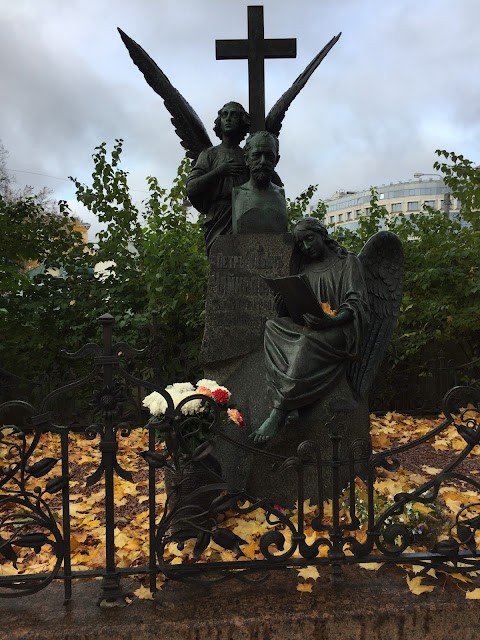150. Tikhvin Cemetery
Tikhvin Cemetery is located just outside of Saint Alexander Nevsky Monastery at the eastern side of the Tsentralny District. The cemetery is bisected by a large path, with either side enclosed by a high fence. The western portion is known as the necropolis of Art Masters and the eastern cemetery is known as the necropolis of the 18th century.
The necropolis of Art Masters is filled with the graves of notable writers, composers, and actors who lived and died in St. Petersburg. The highlights here are undoubtedly the graves of the writer Fyodor Dosteyevsky (1821-1881) and the composers Pyotr Tchaikovsky (1840-1893), Modest Mussorgsky (1839-1881), and Nikolai Rimsky-Korsakov (1844-1908).
The necropolis of the 18th century, with a significantly denser population of residents, contains the graves of notable politicians, scientists, architects, and a few artists who perhaps did not make the cut to be considered an "art master". Notable burials include scientist Mikhail Lomonosv (1711-1765), Natalia Lanskaya (1812-1863) (Alexander Pushkin's wife/widow), and Andrey Voronikhin (1759-1814) (the architect who designed Kazan Cathedral and Stroganov Palace in St. Petersburg, as well as worked on suburban palaces in Gatchina and Pavlovsk). By far the most exciting to me of this group is the burial of my favorite St. Petersburg architect, Carlo Rossi (1775-1849), who designed numerous important buildings throughout the city (including the General Staff Building, Alexandrinsky Theater, Mikhailovsky Palace, Rossi Street buildings, and Yelagin Palace, among many others).
These cemeteries are both relatively small, and have perhaps the best ratio of famous to non-famous burials of any cemetery I've ever been to (not counting places like Westminster Abbey in London or the Cathedral of Saints Peter and Paul in St. Petersburg). Each one had a small museum - an exhibition hall with modern sculptures in the west cemetery and the burial vault of St. Lazarus in the eastern necropolis (known as the "Monument of Russian History and Culture XVIII-XIX Centuries", which was filled with grave markers and burials moved from other sites). Tikhvin Cemetery is a less-visited side of St. Petersburg, and I had the area mostly to myself on a gorgeous autumn day.
The necropolis of Art Masters:
Fyodor Dostoevsky:
N. Karamzin (1766-1826) - a writer and historian:
Alexander Borodin (1833-1887) - a composer (not sure why it says 1834 on the monument but I think that's incorrect):
Pyotr Tchaikovsky:
Miscellaneous graves:
The row of composers:
The Exhibition Hall:
Modest Mussorgsky:
Ivan Krylov (1769-1844) - a fabulist:
Natalia Lanskaya:
Carlo Rossi:
Andrey Voronikhin:
Miscellaneous graves:
Mikhail Lomonosov (also protected from the cold weather):
St. Lazarus Church - Monument of Russian History and Culture XVIII-XIX Centuries:
The necropolis of Art Masters is filled with the graves of notable writers, composers, and actors who lived and died in St. Petersburg. The highlights here are undoubtedly the graves of the writer Fyodor Dosteyevsky (1821-1881) and the composers Pyotr Tchaikovsky (1840-1893), Modest Mussorgsky (1839-1881), and Nikolai Rimsky-Korsakov (1844-1908).
The necropolis of the 18th century, with a significantly denser population of residents, contains the graves of notable politicians, scientists, architects, and a few artists who perhaps did not make the cut to be considered an "art master". Notable burials include scientist Mikhail Lomonosv (1711-1765), Natalia Lanskaya (1812-1863) (Alexander Pushkin's wife/widow), and Andrey Voronikhin (1759-1814) (the architect who designed Kazan Cathedral and Stroganov Palace in St. Petersburg, as well as worked on suburban palaces in Gatchina and Pavlovsk). By far the most exciting to me of this group is the burial of my favorite St. Petersburg architect, Carlo Rossi (1775-1849), who designed numerous important buildings throughout the city (including the General Staff Building, Alexandrinsky Theater, Mikhailovsky Palace, Rossi Street buildings, and Yelagin Palace, among many others).
These cemeteries are both relatively small, and have perhaps the best ratio of famous to non-famous burials of any cemetery I've ever been to (not counting places like Westminster Abbey in London or the Cathedral of Saints Peter and Paul in St. Petersburg). Each one had a small museum - an exhibition hall with modern sculptures in the west cemetery and the burial vault of St. Lazarus in the eastern necropolis (known as the "Monument of Russian History and Culture XVIII-XIX Centuries", which was filled with grave markers and burials moved from other sites). Tikhvin Cemetery is a less-visited side of St. Petersburg, and I had the area mostly to myself on a gorgeous autumn day.
The necropolis of Art Masters:
Fyodor Dostoevsky:
N. Karamzin (1766-1826) - a writer and historian:
Alexander Borodin (1833-1887) - a composer (not sure why it says 1834 on the monument but I think that's incorrect):
Pyotr Tchaikovsky:
Arkhip Kuindzhi (1841-1910) - an artist:
Miscellaneous graves:
The row of composers:
The Exhibition Hall:
Modest Mussorgsky:
Nikolai Rimsky-Korsakov (protected from the elements for the winter):
Ivan Krylov (1769-1844) - a fabulist:
The necropolis of the 18th century:
Natalia Lanskaya:
Carlo Rossi:
Andrey Voronikhin:
Miscellaneous graves:
Mikhail Lomonosov (also protected from the cold weather):
St. Lazarus Church - Monument of Russian History and Culture XVIII-XIX Centuries:


































































Comments
Post a Comment